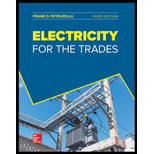
ELECTRICITY FOR TRADES (LOOSELEAF)
3rd Edition
ISBN: 9781260437454
Author: Petruzella
Publisher: MCG
expand_more
expand_more
format_list_bulleted
Concept explainers
Textbook Question
Chapter 2.1, Problem 6RQ
Normally every atom contains an ___________ number of electrons and protons, making its combined electric charge __________.
Expert Solution & Answer
Want to see the full answer?
Check out a sample textbook solution
Students have asked these similar questions
FILL IN THE BLANKS
1)When a positively charged metal touches an electroscope, electrons transfer from ______.2)Charging by ________________ is when two materials are brought into contact. 3)Charging by ________________ is when two materials are rubbed together. When a material has freely moving valence electrons, it is likely to be ___________________ . 4)As we add more charges in a certain location, electric field strength __________________ . 5)Charging by ______________ happens when an object effect on charges without contact and involves _________________ which means rearrangement of the charges in a neutral object.
Ideally, all atoms have the same number of protons and electrons, therefore all atoms are considered as _________.
Select one:
a.
electrically neutral
b.
magnetically aligned
c.
physically stable
d.technically rigid
One Coulomb is equal to ____________ electrons or protons stored in a dielectric
Chapter 2 Solutions
ELECTRICITY FOR TRADES (LOOSELEAF)
Ch. 2.1 - What three particles can be found within an atom?Ch. 2.1 - Which particle has a negative charge and rotates...Ch. 2.1 - Which particle of an atom has a positive charge?Ch. 2.1 - Compare the size and mass (weight) of the electron...Ch. 2.1 - Prob. 5RQCh. 2.1 - Normally every atom contains an ___________ number...Ch. 2.1 - Prob. 7RQCh. 2.1 - Prob. 8RQCh. 2.1 - Prob. 9RQCh. 2.1 - Prob. 10RQ
Ch. 2.2 - _________ electrons are found in the outermost...Ch. 2.2 - Whenever a valence electron is removed from its...Ch. 2.2 - Prob. 3RQCh. 2.2 - Conductors offer _________ resistance to current...Ch. 2.2 - Conductors have incomplete valence shell of...Ch. 2.2 - Insulators have few, if any, _______ electrons.Ch. 2.2 - Semiconductors have some of the characteristics of...Ch. 2.2 - Two examples of pure semiconductor materials are...Ch. 2.2 - Explain the main characteristic of a semiconductor...Ch. 2.2 - What is voltage similar to?Ch. 2.2 - Electric current refers to the flow of _________...Ch. 2.2 - Compare the resistance of a conductor with that of...Ch. 2.2 - What does the circuit of a simple battery-operated...Ch. 2.2 - Prob. 14RQ
Knowledge Booster
Learn more about
Need a deep-dive on the concept behind this application? Look no further. Learn more about this topic, electrical-engineering and related others by exploring similar questions and additional content below.Similar questions
- 1. The practical unit of electric charge. ____________ 2. A path for the current to flow. ______________ 3. DC Voltage has ________ polarity 4. Resistance to current flow in AC circuits, measured in ohms. ____________ 5-7. Types of grounds in electrical/electronics circuits. (5) ______________ (6) ______________ (7) ______________ 8. Also known as Ohm’s Law. ________________arrow_forwardWhat is the types of material that has 4 valence electrons. One Coulomb is equal to ____________ electrons or protons stored in a dielectric.arrow_forwardthe number of protons that determines the atomic weight, the atomic number, and what?arrow_forward
- With a second .01-µF capacitor. Remove the jumper from points A and B. Carefully discharge C1 insert the second capacitor (C2)in series with C1 Insert a jumper between points A and B and note the charge time of C1and C2in series.The Charge time was approximately how many seconds? Since the charge time has decreased to ____________________ the value it was withonly C1 in the circuit, it may be concluded that the total capacitance has (increased ordecreased)? the new RC time is (double or half)? the original and the R has not been changed, we concludethat the new total capacitance is how _____µF.arrow_forwardAlternating current is __________. Select one: A. AN ALTERNATING FLOW OF ELECTRONS B. ELECTRONS REVERSING THEIR FLOW AT REGULAR INTERVALS C. THE MOST COMMONLY USED CURRENT D. ALL OF THE ABOVEarrow_forwardWhat will be the total charge of an assembly of 12389 electrons?arrow_forward
- 1: The intrinsic breakdown is assumed to occur when electrons in solid sample gain sufficient energy from the applied field to cross the _____________ energy from the valence dielectric to conduction band. 2:Treeing phenomenon is observed in _________________.arrow_forwardWhat is the maximum number or electrons that can exist in the 3rd shell of an atom? Please explain properly. Will give thumbs up.arrow_forward1: ____________ damage occurred upon breakdown and the insulator needs to be replaced with the new one. 2:The liquid dielectrics contain voids or cavities within the medium or at the boundaries between the dielectric and the electrodes. The electric field strength in the voids is ____________ than that across the dielectric.arrow_forward
- Compare dry-cells, alkaline batteries and nickel-cadmium, when it comes to improvements and capacity.arrow_forward1. A quantity defined as amount of work done over time. _____________ 2. Types of material that has 4 valence electrons. _____________ 3. One Coulomb is equal to ____________ electrons or protons stored in a dielectric. 4. Best conductor material type. _____________ 5. Best insulator material type. _____________ 6. The value of a resistor without considering its tolerance value percentages. _____________ 7. 1 picoampere (pA) is equal to __________ ampere (A).arrow_forwardA semiconductor is a material that has _____ energy band gap. a)no b)wide c)narrow d)nucleararrow_forward
arrow_back_ios
SEE MORE QUESTIONS
arrow_forward_ios
Recommended textbooks for you
 Electricity for Refrigeration, Heating, and Air C...Mechanical EngineeringISBN:9781337399128Author:Russell E. SmithPublisher:Cengage Learning
Electricity for Refrigeration, Heating, and Air C...Mechanical EngineeringISBN:9781337399128Author:Russell E. SmithPublisher:Cengage Learning Delmar's Standard Textbook Of ElectricityElectrical EngineeringISBN:9781337900348Author:Stephen L. HermanPublisher:Cengage Learning
Delmar's Standard Textbook Of ElectricityElectrical EngineeringISBN:9781337900348Author:Stephen L. HermanPublisher:Cengage Learning

Electricity for Refrigeration, Heating, and Air C...
Mechanical Engineering
ISBN:9781337399128
Author:Russell E. Smith
Publisher:Cengage Learning

Delmar's Standard Textbook Of Electricity
Electrical Engineering
ISBN:9781337900348
Author:Stephen L. Herman
Publisher:Cengage Learning
Conductivity and Semiconductors; Author: Professor Dave Explains;https://www.youtube.com/watch?v=5zz6LlDVRl0;License: Standard Youtube License